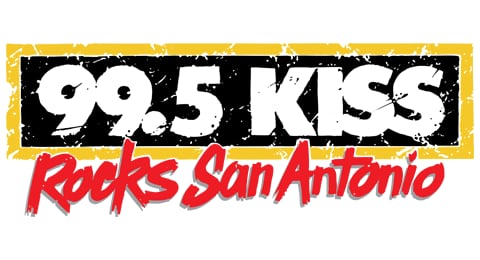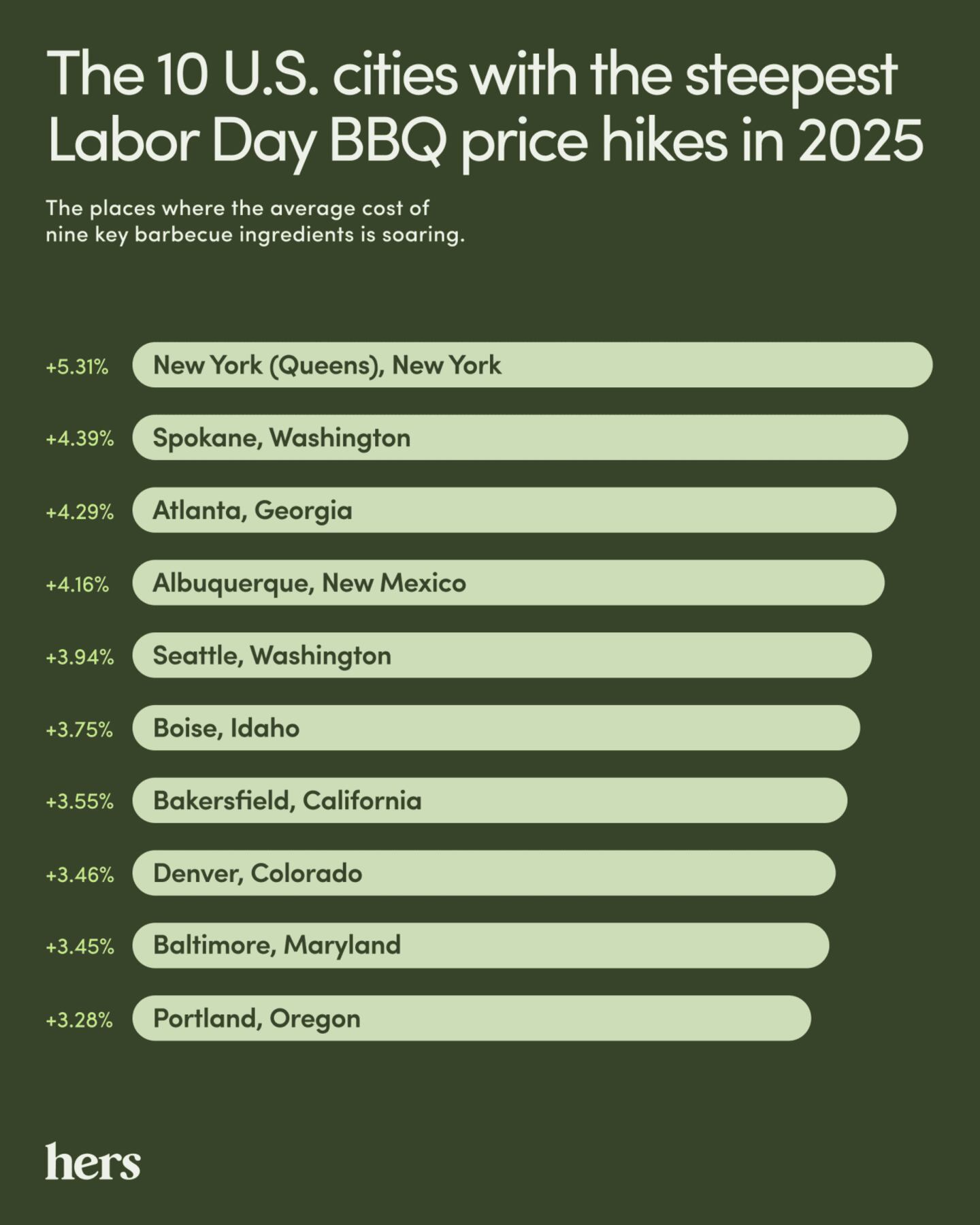The cost of a Labor Day BBQ by city
Labor Day weekend is prime time for backyard barbecues, but you might feel the heat before the grill even fires up. Prices for cookout staples like steak, chicken, and soda have jumped since last summer — and in some cities, the increase is steep.
As of July, Bureau of Labor Statistics data shows grocery prices are up 2.2%year over year, continuing a trend that began with pandemic-era supply chain disruptions. In the months to come, there may be more price shocks due to economic uncertainty related to tariffs. In a July AP-NORC poll, over half of Americans cited grocery costs as a major source of stress.
Higher costs at your local grocery store make it harder to stay on budget — especially when you're feeding a crowd. Rising prices can also push shoppers toward cheaper, ultraprocessed foods instead of healthier, fresh foods.
Hers examined the price changes for nine popular barbecue staples to find the U.S. cities with the steepest cost increases. Individual items are broken down so you can spot easy ingredient swaps for more affordable alternatives.
Key Findings
- New York City (Queens), Spokane, Washington, and Atlanta had the most significant percentage increases in total average barbecue cost. Each of the three cities showed prices rising in at least five of the seven ingredient categories analyzed.
- The total average cost of the nine ingredients analyzed was the highest in Honolulu, San Francisco, and Seattle. Honolulu was the only city on the list that topped $70.
- Ground beef and cooking oil displayed some of the largest price increases from a year ago. In San Jose, California, for example, ground beef and oil each rose by more than 10% in a one-year period.
- Even in the cities where the total cost of a barbecue fell from a year ago, prices for steak, cooking oil, and lettuce still showed notable increases. Beef prices have risen to record highs in recent months as demand has far outpaced supply.
Ready to find out how prices have changed in your city? This list is ranked based on nine key barbecue ingredients, and the methodology is explained in depth below.
Hers
Cities Where the Cost of a Labor Day Barbecue Is Increasing
- New York (Queens), New York +5.31%
- Spokane, Washington +4.39%
- Atlanta, Georgia +4.29%
- Albuquerque, New Mexico +4.16%
- Seattle, Washington +3.94%
- Boise, Idaho +3.75%
- Bakersfield, California +3.55%
- Denver, Colorado +3.46%
- Baltimore, Maryland +3.45%
- Portland, Oregon +3.28%
Cities Where the Cost of a Labor Day Barbecue Is Decreasing
- Morristown, New Jersey -3.35%
- New York (Brooklyn), New York -2.68%
- Douglasville, Georgia -2.45%
- Plano, Texas -1.04%
- Dayton, Ohio -0.98%
- Oklahoma City, Oklahoma -0.93%
- San Antonio, Texas -0.91%
- Little Rock, Arkansas -0.89%
- Fayetteville, Arkansas -0.64%
- Tulsa, Oklahoma -0.51%
Barbecue Prices: Trends and Insights
Are you wondering how grocery price increases are impacting specific food categories? Here is a deeper look at the data to help you make mindful choices based on your budget.
What Is the Price of Steak in 2025?
Cities Where Steak Is the Most Expensive
- Oakland, California ($16.02 per pound)
- San Francisco, California ($16.00)
- Honolulu, Hawai'i ($15.97)
Cities Where Steak Is the Least Expensive
- San Marcos, Texas ($14.82)
- Denton, Texas ($14.83)
- Houston, Texas ($14.83)
What Is the Price of Chicken in 2025?
Cities Where Chicken Is the Most Expensive
- Honolulu, Hawai'i ($7.57 per pound)
- Los Angeles, California ($6.65)
- Baltimore, Maryland ($6.64)
Cities Where Chicken Is the Least Expensive
- Dallas, Texas ($3.99)
- San Antonio, Texas ($4.13)
- Las Vegas, Nevada ($4.15)
What Is the Price of Beer in 2025?
Cities Where Beer Is the Most Expensive
- Bergen, New Jersey ($12.40 for a six-pack)
- Portland, Oregon ($12.26)
- Philadelphia, Pennsylvania ($12.19)
Cities Where Beer Is the Least Expensive
- Jackson, Mississippi ($9.10)
- Madison, Wisconsin ($9.12)
- Reno, Nevada ($9.27)
Methodology: How The Ranking Is Calculated
The analysis began with the quarterly Cost of Living Index from The Council for Community and Economic Research (C2ER). From this dataset, researchers pulled prices for nine barbecue staples: steak, ground beef, sausage, chicken, lettuce, cooking oil, potato chips, Coca-Cola, and beer.
For each city in C2ER’s data set, researchers recorded the population estimate from the most recent Census data, and then eliminated regions with a population of less than 500,000. That allowed for streamlining the list, focusing on larger and more well-known cities.
Researchers then compared the average price for each ingredient in the first quarter of 2025 to the first quarter of 2024, as well as the year-over-year change for the total price of the nine ingredients. The primary ranking is based on the percent changes in total average price, though individual ingredients were also analyzed, as seen above.
Get the data here.
Tips for Staying Healthy on a Budget
Inflation may be driving up food costs, but you can still eat well and stay active without overspending. Whether you’re planning a Labor Day cookout or just trying to keep your weekly grocery bill in check, these budget-friendly health tips will help you maintain healthy habits without breaking the bank.
- Stay flexible with your grocery list. Prices for staples like protein and produce may fluctuate over time, so it's important to get comfortable swapping chicken for steak or carrots for broccoli. As costs shift, you may also consider choosing cheaper proteins like beans or tinned fish, or tasting a new fruit or vegetable you haven't tried before when it goes on sale. Research shows that eating a diversity of healthy foods can protect against cognitive decline and Type 2 diabetes.
- Get creative with at-home wellness. YouTube and free apps provide plenty of options for exercising or practicing mindfulness without breaking the bank. You might also consider walking outside in the summer months rather than paying for a gym or stretching in your living room. A study published in the European Heart Journal in 2022 showed that just 15 to 20 minutes of vigorous exercise a week reduced mortality and disease incidence.
- Choose water first. Staying hydrated has been proven to keep you focused, help with digestion, and reduce the effects of heart conditions like hypertension. Thankfully, water is the most efficient and affordable way of doing so. Sodas, juices, and alcohol can be pricey and, in some cases, make you more dehydrated. Carry a reusable water bottle to make sipping throughout the day easier and more sustainable.
This story was produced by Hers and reviewed and distributed by Stacker.










